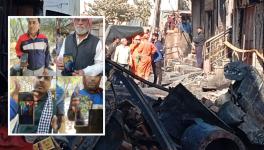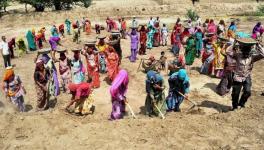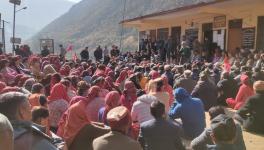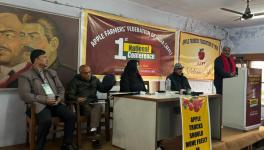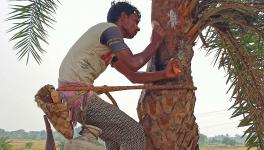Rohtang Tunnel – Remember the Workers who Built it
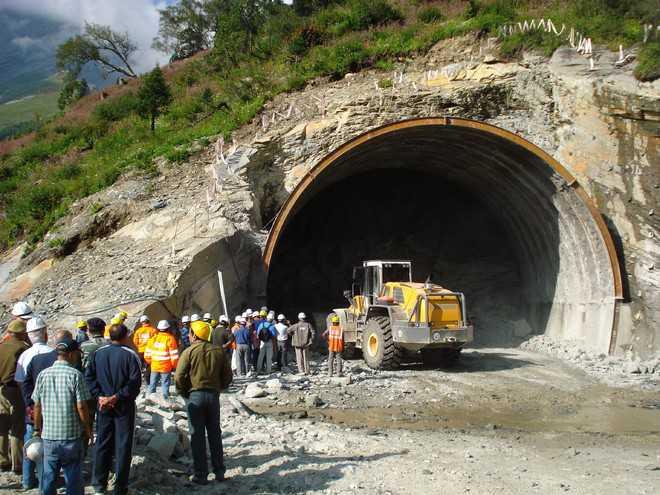
Rohtang tunnel. Image Courtesy: The Tribune
A few days from now, the Rohtang Tunnel will be inaugurated and made accessible to the people of Lahaul, Ladakh and to the Indian Army to transport supplies and other equipment to the Sino-Indian border. Tourists visiting Manali will have access to the pristine beauty of Lahaul and Spiti – the largest district in Himachal Pradesh. The accessibility will also increase the vulnerability of the fragile ecology of the region. However, that is for later.
For the moment, let us focus on the Rohtang Tunnel, which will continue to hit headlines for a week or so as the prime minister is supposed to inaugurate it on October 3, 2020. Having said that, the propaganda machinery of the Modi government will leave no stone unturned (it has already begun) to show how serious the government is about protecting the borders and serving people closer to them.
The demand to develop border areas is not new. As far back as the late 1950s, two officers of the state government (both block development officers) Thakur Devi Singh and Thakur Shiv Chand raised a slogan for intervention by the Centre. ‘Peking nazdeek hai, Delhi door hai’ (Peking is close, Delhi is far). It took the Centre by surprise and which began the process of border development.
The Border Roads Organisation (BRO) was established by the Nehru government in 1960 to develop and maintain road networks in India’s border areas. Not just roads, but other infrastructure development also took pace. After the Sino-India war in 1962, a greater emphasis was laid on infrastructure development in border areas.
Lal C. Dhissa, a former IAS officer who left service at the young age of 34, said that the two officers were the ones who guided the Indian Army to combat raiders in Ladakh in 1948. Both Shiv Chand and Devi Singh later went to Delhi, met Dr. B.R. Ambedkar and got Lahaul & Spiti the Scheduled Tribe status. In 1971, Thakur Devi Singh became a forest minister in the state cabinet of the first government of Himachal Pradesh led by Dr. Y.S. Parmar.
Why a Tunnel under Rohtang?
The Rohtang pass is at an altitude of 13,058 feet above sea level, and for six months every year, the snow road cuts the Lahaul and Spiti valley from the rest of the country. It also cuts supply to border areas in Ladakh. Rohtang is in the Pir Panjal range which extends to Jammu and Kashmir in the Himalayas. A tunnel under Rohtang will make the border region accessible for motorable traffic throughout the year.
The idea of a tunnel under Rohtang was first talked about in 1960 by the Moravian mission. However, a foundation for the idea of a tunnel was laid down by Indira Gandhi, former prime minister of India and Lata Thakur, a former MLA from Lahaul and Spiti, and then later by A.B. Vajpayee, the former prime minister, in 2000. Funds for the same were allotted by the UPA – 1 government and Sonia Gandhi, its chairperson, laid the foundation stone on June 28, 2010.
The tunnel project was awarded to a joint venture comprising AFCON, an Indian company, and STRABAH AG, an Austrian company, in September 2009. The tunnel work was supposed to be over by 2014, but due to loose strata while digging the tunnel at Seri Nallah, work was delayed. The project, which will be inaugurated on October 3, is now worth Rs 4,000 crore as opposed to the initial estimate of Rs 1,500 crore.
An Engineering Marvel
The tunnel has been constructed at a height of nearly 10,000 feet above sea level. Aside from the main tunnel, which is 9.02 kilometres in length, and will allow two-way traffic to pass through, there is another tunnel of the same length underneath for rescue and safety operations. While the ‘headrace’ tunnel, or the main tunnel, is almost ten metres wide, the one underneath has enough width to accommodate a car.
The tunnel, unlike an ordinary passage, will have a telephone at every 150 metres, a fire hydrant at every 60 metres, emergency exits to the underground tunnel at every 500 metres, air quality monitoring systems every kilometre and automatic incident detection system with CCTV camers every 250 metres.
Don’t Forget the Workers
In the entire propaganda blitz, no one is speaking about the workers who worked day and night to construct the Rohtang Tunnel. There were nearly 3,000 workers who were engaged from Odisha, Jharkhand, Nepal, Bihar and Himachal Pradesh. I remember one of the anecdotes while leading a struggle of the workers who were constructing a tunnel as part of hydro project in the Satluj basin in Himachal Pradesh.
After a strike for a couple of days, the management agreed to pay what the workers’ union was demanding. The owner of the company which was building the project asked me if I knew why it had accepted our terms and conditions. “Because of our strength and the might of the united workers’ union,” I replied. He said that was partially correct; their foremost reason for accepting the demands was that he could not “afford to lose ‘the best drillers in the world’”. By that he meant workers from Jharkhand who are considered to be the best at drilling a tunnel underneath the mountain. This capacity of the workers was seen during the drilling at the Rohtang tunnel but hardly acknowledged in the run-up to the inauguration.
Safety Measures
Unlike other tunnel projects, especially done during the construction of hydro-power projects, there is a unique peculiarity in the construction of the Rohtang tunnel. In 2009, a major avalanche in Rani Nallah buried 14 workers from the BRO. Such work in the mountains is hazardous and tunnels are all the more vulnerable. In almost all the tunnel projects, a large number of workers are lost owing to the uncertainty of loose strata falling on them. However, not a single worker died while building this tunnel. Why? I happened to interview some of the leaders of a workers union led by the CITU. The reason they give is that the foreign counterpart in the joint venture, STRABAG AG, maintained very high standards of safety measures while constructing this tunnel. They never allowed the workmen to enter the tunnel if there was even an iota of suspicion of loose strata falling; a lesson which must be learned by officers executing various other projects. Likewise, the two portals at the north and south end of the tunnel are equipped with 24/7 monitoring of the safety challenges in the tunnel.
Hence, the project which will be inaugurated in a few days from now is a long-drawn plan executed by successive governments. Any effort to downplay the other or overplay itself will not be judicious, either to the plan or the project.
Get the latest reports & analysis with people's perspective on Protests, movements & deep analytical videos, discussions of the current affairs in your Telegram app. Subscribe to NewsClick's Telegram channel & get Real-Time updates on stories, as they get published on our website.












